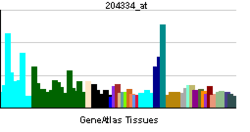KLF7
| KLF7 | ||||||
|---|---|---|---|---|---|---|
| Identifiers | ||||||
| Aliases | KLF7, UKLF, Kruppel-like factor 7 (ubiquitous), Kruppel like factor 7 | |||||
| External IDs | MGI: 1935151 HomoloGene: 2751 GeneCards: KLF7 | |||||
| RNA expression pattern | ||||||
 | ||||||
| More reference expression data | ||||||
| Orthologs | ||||||
| Species | Human | Mouse | ||||
| Entrez | ||||||
| Ensembl | ||||||
| UniProt | ||||||
| RefSeq (mRNA) | ||||||
| RefSeq (protein) | ||||||
| Location (UCSC) | Chr 2: 207.07 – 207.17 Mb | Chr 1: 64.03 – 64.12 Mb | ||||
| PubMed search | [1] | [2] | ||||
| Wikidata | ||||||
| View/Edit Human | View/Edit Mouse |
Kruppel-like factor 7 (ubiquitous), also known as KLF7, is a protein which in humans is encoded by the KLF7 gene.[3][4]
This protein is a member of the Kruppel-like family of transcription factors.[5]
References
- ↑ "Human PubMed Reference:".
- ↑ "Mouse PubMed Reference:".
- ↑ "Entrez Gene: KLF7 Kruppel-like factor 7 (ubiquitous)".
- ↑ Matsumoto N, Laub F, Aldabe R, Zhang W, Ramirez F, Yoshida T, Terada M (October 1998). "Cloning the cDNA for a new human zinc finger protein defines a group of closely related Krüppel-like transcription factors". The Journal of Biological Chemistry. 273 (43): 28229–37. doi:10.1074/jbc.273.43.28229. PMID 9774444.
- ↑ Bieker JJ (September 2001). "Krüppel-like factors: three fingers in many pies". The Journal of Biological Chemistry. 276 (37): 34355–8. doi:10.1074/jbc.R100043200. PMID 11443140.
Further reading
- Cho SY, Park PJ, Shin HJ, et al. (2007). "(-)-Catechin suppresses expression of Kruppel-like factor 7 and increases expression and secretion of adiponectin protein in 3T3-L1 cells.". Am. J. Physiol. Endocrinol. Metab. 292 (4): E1166–72. doi:10.1152/ajpendo.00436.2006. PMID 17164435.
- Kawamura Y, Tanaka Y, Kawamori R, Maeda S (2006). "Overexpression of Kruppel-like factor 7 regulates adipocytokine gene expressions in human adipocytes and inhibits glucose-induced insulin secretion in pancreatic beta-cell line.". Mol. Endocrinol. 20 (4): 844–56. doi:10.1210/me.2005-0138. PMID 16339272.
- Kanazawa A, Kawamura Y, Sekine A, et al. (2005). "Single nucleotide polymorphisms in the gene encoding Krüppel-like factor 7 are associated with type 2 diabetes.". Diabetologia. 48 (7): 1315–22. doi:10.1007/s00125-005-1797-0. PMID 15937668.
- Smaldone S, Laub F, Else C, et al. (2004). "Identification of MoKA, a novel F-box protein that modulates Krüppel-like transcription factor 7 activity.". Mol. Cell. Biol. 24 (3): 1058–69. doi:10.1128/MCB.24.3.1058-1069.2004. PMC 321422
 . PMID 14729953.
. PMID 14729953. - Ota T, Suzuki Y, Nishikawa T, et al. (2004). "Complete sequencing and characterization of 21,243 full-length human cDNAs.". Nat. Genet. 36 (1): 40–5. doi:10.1038/ng1285. PMID 14702039.
- Suzuki S, Chuang LF, Doi RH, Chuang RY (2004). "Identification of opioid-regulated genes in human lymphocytic cells by differential display: upregulation of Krüppel-like factor 7 by morphine.". Exp. Cell Res. 291 (2): 340–51. doi:10.1016/S0014-4827(03)00408-7. PMID 14644156.
- Strausberg RL, Feingold EA, Grouse LH, et al. (2003). "Generation and initial analysis of more than 15,000 full-length human and mouse cDNA sequences.". Proc. Natl. Acad. Sci. U.S.A. 99 (26): 16899–903. doi:10.1073/pnas.242603899. PMC 139241
 . PMID 12477932.
. PMID 12477932. - Matsumoto N, Laub F, Aldabe R, et al. (1998). "Cloning the cDNA for a new human zinc finger protein defines a group of closely related Krüppel-like transcription factors.". J. Biol. Chem. 273 (43): 28229–37. doi:10.1074/jbc.273.43.28229. PMID 9774444.
External links
- KLF7 protein, human at the US National Library of Medicine Medical Subject Headings (MeSH)
This article is issued from Wikipedia - version of the 6/1/2016. The text is available under the Creative Commons Attribution/Share Alike but additional terms may apply for the media files.